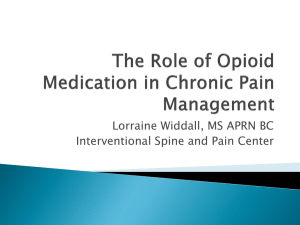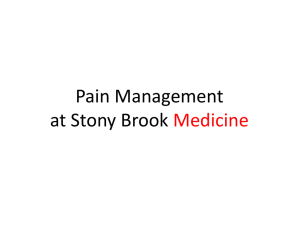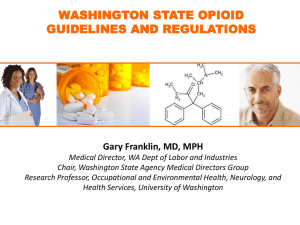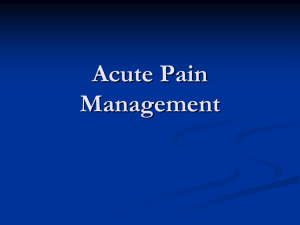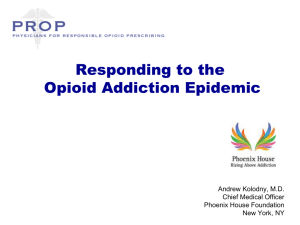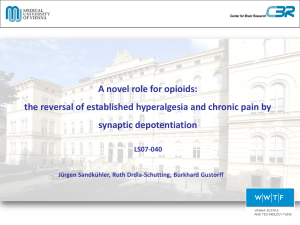Opioid Analgesics
advertisement
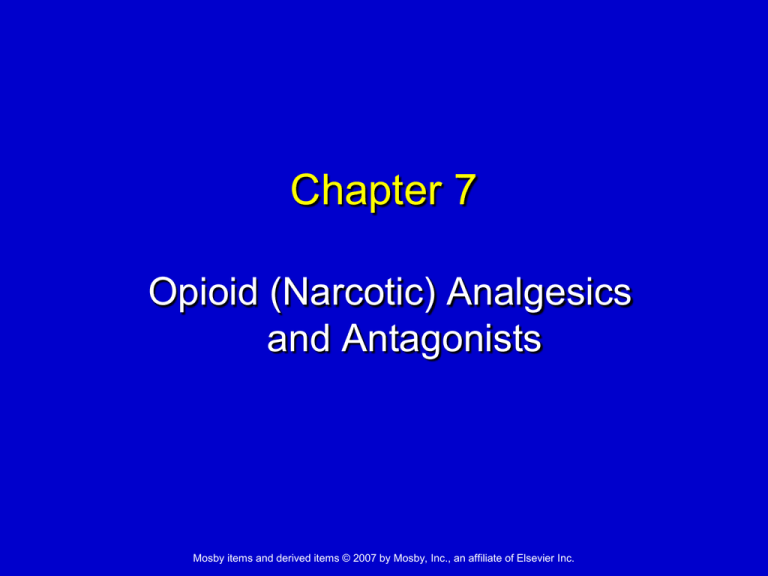
Chapter 7 Opioid (Narcotic) Analgesics and Antagonists Mosby items and derived items © 2007 by Mosby, Inc., an affiliate of Elsevier Inc. Opioid Analgesics Opioid (nonnarcotic) analgesics are used to manage dental pain in patients who cannot tolerate NSAIDS or when NSAIDs are contraindicated. Opioid analgesics are divided into three groups—opioid agonists, mixed opioids, and antagonists. Mosby items and derived items © 2007 by Mosby, Inc., an affiliate of Elsevier Inc. 2 Opioid Analgesics Mechanism of Action Opioid analgesics bind to several different opioid receptors in the CNS and spinal cord to produce therapeutic and adverse effects. These drugs alter the patient’s perception or reaction to pain. Opioids can be complete agonists, partial agonists, agonist-antagonists, or antagonists at the receptor site. Mosby items and derived items © 2007 by Mosby, Inc., an affiliate of Elsevier Inc. 3 Opioid Analgesics Mechanism of Action Stimulation of μ receptors produces analgesia, sedation, miosis, pruritus, respiratory depression, euphoria, physical dependence, constipation. Stimulation of κ receptors produces analgesia, sedation, and myosis. Stimulation of δ is thought to produce analgesia. Stimulation of σ receptors produces autonomic stimulation, dysphoria, hallucinations, nightmares, and anxiety. Stimulation of ε receptors produces analgesia. Mosby items and derived items © 2007 by Mosby, Inc., an affiliate of Elsevier Inc. 4 Opioid Analgesics Pharmacokinetics Most opioid analgesics are well absorbed from the gastrointestinal tract. Absorption also occurs from the lungs, nasal and oral mucosa, and the skin. Opioids are bound to plasma protein to varying degrees and are also distributed to the placenta. These drugs are metabolized in the liver and undergo variable first-pass metabolism. These drugs are excreted by the kidneys. Mosby items and derived items © 2007 by Mosby, Inc., an affiliate of Elsevier Inc. 5 Opioid Analgesics Pharmacologic Effects These drugs produce varying degrees of analgesia depending on the strength of the individual drug. Morphine is the opioid agonist by which all others are measured. Opioid analgesics produce euphoria and sedation at usual therapeutic doses. Opioid analgesics depress the cough center in the medulla and produce an antitussive effect. Opioid analgesics increase smooth muscle tone and decrease propulsive contractions and motility. This effect makes them useful for treating diarrhea. Mosby items and derived items © 2007 by Mosby, Inc., an affiliate of Elsevier Inc. 6 Opioid Analgesics Adverse Reactions Adverse reactions are an extension of the opioids’ pharmacologic effects. Adverse reactions are proportional to opioid analgesic strength. Adverse reactions are many and include respiratory depression, nausea and emesis, constipation, myosis, urinary retention, CNS depressant effects, and histamine release. Mosby items and derived items © 2007 by Mosby, Inc., an affiliate of Elsevier Inc. 7 Opioid Analgesics Mosby items and derived items © 2007 by Mosby, Inc., an affiliate of Elsevier Inc. 8 Opioid Analgesics Addiction The degree of addiction is related to opioid analgesic strength. Addiction is usually not a problem in dentistry because the duration of action is short and weaker opioids are used. The rate of development of tolerance is related to the strength of the opioid and the frequency of use. Mosby items and derived items © 2007 by Mosby, Inc., an affiliate of Elsevier Inc. 9 Opioid Analgesics Overdose and Withdrawal The major symptoms of opioid analgesic overdose include respiratory depression, pinpoint pupils, and coma. Withdrawal occurs with the abrupt discontinuation of opioid analgesics. Symptoms include yawning, lacrimation, perspiration, rhinorrhea, gooseflesh, irritability, nausea, vomiting, tachycardia, tremors, chills. Addiction, overdose, and withdrawal can be treated with opioid antagonists. Mosby items and derived items © 2007 by Mosby, Inc., an affiliate of Elsevier Inc. 10 Opioid Analgesics Red Flags of Addiction Asks for the opioid analgesic by name and says that this is the only drug that works for them Patient claims allergies to NSAIDs or lower potency opioid analgesics Calls with a request for an opioid analgesic just as the office is closing or after hours Cancels dental appointment but still requests the opioid analgesic even though they will be “out of town on business” Continually changing practitioners Mosby items and derived items © 2007 by Mosby, Inc., an affiliate of Elsevier Inc. 11 Opioid Analgesics Red Flags of Addiction Claims a “low pain threshold” Experiences pain for days after scaling and root planing Needs refills several days after an uncomplicated dental procedure Mosby items and derived items © 2007 by Mosby, Inc., an affiliate of Elsevier Inc. 12 Opioid Analgesics Allergic Reactions The most common allergic reactions are skin rash and urticaria. They are due to the histamine-releasing properties of opioid analgesics. Drug Interactions Opioid analgesics produce additive CNS depressant effects when given with other drugs that depress the CNS. Mosby items and derived items © 2007 by Mosby, Inc., an affiliate of Elsevier Inc. 13

